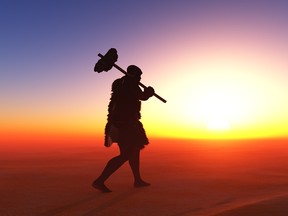World
Neanderthals and Humans Interbred 140,000 Years Ago, Study Reveals

A groundbreaking study has revealed that Neanderthals interbred with our human ancestors approximately 100,000 years earlier than previously believed. Researchers discovered that a child, estimated to have lived around 140,000 years ago, had parents from both species. This significant finding was reported by a team from Tel Aviv University and the Centre for Scientific Research in France, based on tests conducted on fossil remains unearthed in the Skhul Cave in northern Israel nearly 90 years ago.
The fossil, likely a female, provides new insights into the complex relationship between humans and Neanderthals. Lead author and professor Israel Hershkovitz explained that genetic studies over the past decade have shown these two groups exchanged genes. He noted, “Even today, 40,000 years after the last Neanderthals disappeared, part of our genome — 2% to 6% — is of Neanderthal origin.”
Previously, experts believed that significant gene exchange occurred between 60,000 and 40,000 years ago. This study, however, presents a fossil that is over 140,000 years old, indicating that interactions between the two populations began much earlier than anticipated.
Unique Features of the Fossil
The child’s skull exhibits characteristics typical of both Homo sapiens and Neanderthals. The overall shape of the skull resembles that of modern humans, particularly in its curvature. Yet, it also displays features such as an intracranial blood supply system, a lower jaw, and an inner ear structure that is characteristic of Neanderthals. This combination makes the remains the earliest known human fossil to show traits of both species.
The research team has identified this hybrid as representing a new group, which they have named “Nesher Ramla Homo”, after the archaeological site where the remains were found. This finding suggests that Neanderthals inhabited areas of what is now Israel as far back as 400,000 years ago, potentially encountering early humans who began migrating out of Africa around 200,000 years ago.
Implications for Understanding Human History
The discovery of this child represents the earliest evidence of social and biological connections between Neanderthals and early human populations. It sheds light on the dynamics of our evolutionary history and the complex interactions that shaped the genetic makeup of modern humans.
As researchers continue to analyze these findings, they promise to rewrite aspects of our understanding of human ancestry. This study not only highlights the shared history of Neanderthals and humans, but it also underscores the importance of ongoing archaeological work in revealing the intricacies of our past.
This research contributes significantly to the growing body of evidence that underscores a nuanced understanding of human evolution, suggesting that the relationships between different hominin groups were far more intricate than previously thought.
-

 Science2 months ago
Science2 months agoToyoake City Proposes Daily Two-Hour Smartphone Use Limit
-

 Health2 months ago
Health2 months agoB.C. Review Reveals Urgent Need for Rare-Disease Drug Reforms
-

 Top Stories2 months ago
Top Stories2 months agoPedestrian Fatally Injured in Esquimalt Collision on August 14
-

 Technology2 months ago
Technology2 months agoDark Adventure Game “Bye Sweet Carole” Set for October Release
-

 World2 months ago
World2 months agoJimmy Lai’s Defense Challenges Charges Under National Security Law
-

 Technology2 months ago
Technology2 months agoKonami Revives Iconic Metal Gear Solid Delta Ahead of Release
-

 Technology2 months ago
Technology2 months agoSnapmaker U1 Color 3D Printer Redefines Speed and Sustainability
-

 Technology2 months ago
Technology2 months agoAION Folding Knife: Redefining EDC Design with Premium Materials
-

 Business2 months ago
Business2 months agoGordon Murray Automotive Unveils S1 LM and Le Mans GTR at Monterey
-

 Technology2 months ago
Technology2 months agoSolve Today’s Wordle Challenge: Hints and Answer for August 19
-

 Lifestyle2 months ago
Lifestyle2 months agoVictoria’s Pop-Up Shop Shines Light on B.C.’s Wolf Cull
-

 Technology2 months ago
Technology2 months agoApple Expands Self-Service Repair Program to Canada









